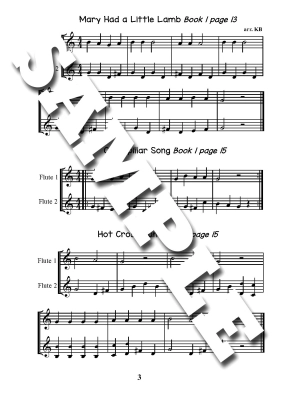Opens in a new window
Blocki Flute Method Flute Zoo Duet Book - Blocki - Flute Duets - Book

Additional Photos:



- Author/Composer:
- BLOCKI, KATHY
- Instrumentation:
- FLUTE DUET
- Model #:
- FZBOOK-D
Format: Book
Instrumentation: Flute Duets
Flute Zoo Books are the new fun, and engaging way to learn to play the flute. These books, with their bright colours and cheerful imagery, were written with elementary age flute students in mind, although we have found that older children (and even adults) love the fun songs and activities as well! Each book is between 32 and 40 pages long. So the new flutist will gain a strong sense of accomplishments as they more quickly earn their certificate for Flute Zoo book one.
Flute Zoo Duet Book
Students love duets! In these 43 duets, the first flute part of each duet is found in Flute Zoo Books 1 - 3. Consequently, the first flute parts are written in progressive order of difficulty. The second flute part is written for the teacher or a more advanced flutist. These second flute parts are not in progressive order. Many of the duets work well in group settings and as flute choir pieces by having the beginning students play the first flute parts and more advanced students play the second flute parts. Just as young choirs often sing with only two parts, this also works well with flutists. This is an excellent way to have all the students play together at the end of a recital.
These duets contain great literature for the beginner's first years of playing and also work well as recital pieces. Having students play a duet with their teacher during their
first few recitals will greatly aid in easing recital nerves and will help to ensure success.
It is so rewarding to see a student's eyes light up when playing duets. Even as a college student while studying with Samuel Baron, I always looked forward to playing a duet with him at the end of each lesson. Duets are fun but important for developing ensemble skills and an early concept of playing in tune. The teacher should be sure to quickly adjust pitch so that the student hears great intonation and in tune intervals become the norm. Tuning at this level is not possible with a large group of beginners. That is why it is so essential for students to develop this skill, first with their private teacher, then with small ensembles, and finally with large ensembles. As the student develops, the responsibility to match pitch and tune intervals should gradually be transferred from the teacher to the student.
The Flute Zoo Advantage
Tone: With Flute Zoo books students learn both high and low notes on the head joint. Playing in the high and low octave continues when students begin with the whole flute. This gives the new flutist an enormous advantage and teaches embouchure flexibility which is vital for becoming a great flute player. Teaching flute is not like teaching trumpet in which the high notes are more difficult. High notes become difficult when students only play in the low and middle octaves for as much as one year. The students then have trouble with embouchure flexibility, and the ability to form a smaller lip opening. Listen to this young beginner accidentally playing in three octaves!
Rhythm: Flute Zoo books 1-3 and the Five-Note Fun Sticker Book work together to insure a solid rhythmic foundation. Towards the end of Flute Zoo Book 2 students are reading rhythms that may appear simple, but imply more difficult rhythms. They learn how to play rhythms like a dotted quarter note followed by an eighth long before they actually read it. In Flute Zoo Book 3, students use the rhythm cards in the back of their book to first play these rhythms with tied eighth notes. Then the card is flipped over to reveal how the rhythm would be written without tied notes.
The Five-Note Fun Sticker Book helps to instill the ability to move between beat levels with ease. This foundation is essential for playing the complex rhythms they will encounter in Blocki Flute Method Book 3.
Creative Composing: These projects develop creativity and highlight the new concepts being learned. Each Flute Zoo Book contains several engaging composition activities.
What is the difference between Blocki Flute Method Book 1 and the Flute Zoo Book?
The content in the Blocki Flute Method Book 1 equals Flute Zoo Books 1, 2 and 3. The Flute Zoo books move at a slightly slower pace and are shorter giving a sense of accomplishment as they finish each book more quickly. The Flute Zoo Five-Note Fun Sticker Book is essential to the Flute Zoo series but can also be used with the Blocki Flute Method Book 1.
After working through all four Flute Zoo books, students will be ready to start in Blocki Flute Method Book 2. The Blocki Flute method was designed to give the beginner an excellent foundation in beautiful tone, embouchure flexibility, rhythm and technique. This comprehensive and step-by-step approach was written to ensure success and includes theory and composition projects.
Q & A
There are currently no questions for this product.
Reviews
There are currently no reviews for this product. Be the first to write one!





